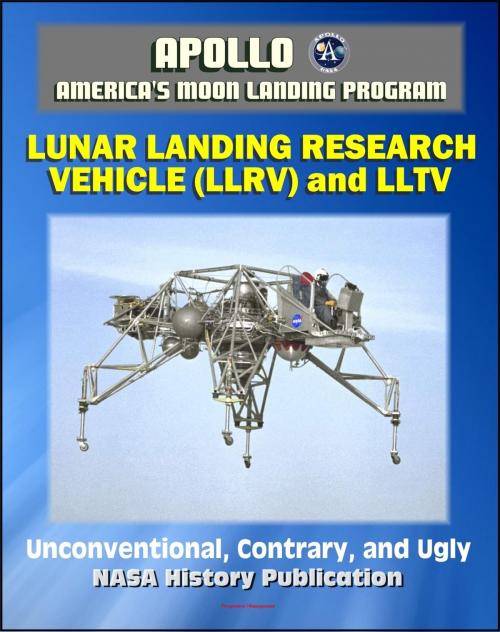Apollo and America's Moon Landing Program: Unconventional, Contrary, and Ugly: The Lunar Landing Research Vehicle (NASA SP-2004-4535) - Design and Development, LLTV, Armstrong
Nonfiction, Science & Nature, Science, Physics, Astronomy, History, Americas| Author: | Progressive Management | ISBN: | 9781465991911 |
| Publisher: | Progressive Management | Publication: | December 10, 2011 |
| Imprint: | Smashwords Edition | Language: | English |
| Author: | Progressive Management |
| ISBN: | 9781465991911 |
| Publisher: | Progressive Management |
| Publication: | December 10, 2011 |
| Imprint: | Smashwords Edition |
| Language: | English |
This official NASA history document - converted for accurate flowing-text e-book format reproduction - is the complete story of the important training vehicle for the Apollo moon landings, the Lunar Landing Research Vehicle (LLRV) and the later version, the Lunar Landing Training Vehicle (LLTV). In the foreword, Neil Armstrong writes:
"Unconventional, Contrary, & Ugly: The Lunar Landing Research Vehicle tells the complete story of this remarkable machine, the Lunar Landing Research Vehicle, including its difficulties, its successes, and its substantial contribution to the Apollo program. The authors are engineers who were at the heart of the effort. They tell the tale that they alone know and can describe. Six crews landed their Lunar Modules on the moon. They landed on the dusty sands of the Sea of Tranquility and the Ocean of Storms. They landed in the lunar highlands at Fra Mauro and on the Cayley Plains. They landed near the Apennine and Taurus Mountains. Each landing, in widely different topography, was performed safely under the manual piloting of the flight commander. During no flight did pilots come close to sticking a landing pad in a crater or tipping the craft over. That success is due, in no small measure, to the experience and confidence gained in the defining research studies and in the pilot experience and training provided by the LLRV and LLTV. Someday men will return to the moon. When they do, they are quite likely to need the knowledge, the techniques, and the machine described in this volume."
When the United States began considering a piloted voyage to the moon, an enormous number of unknowns about strategies, techniques, and equipment existed. Some people began wondering how a landing maneuver might be performed on the lunar surface.
From the beginning of the age of flight, landing has been among the most challenging of flight maneuvers. Touching down smoothly has been the aim of pilots throughout the first century of flight. Designers have sought the optimum aircraft configuration for landing. Engineers have sought the optimum sensors and instruments for best providing the pilot with the information needed to perform the maneuver efficiently and safely. Pilots also have sought the optimum trajectory and control techniques to complete the approach and touchdown reliably and repeatably.
Landing a craft on the moon was, in a number of ways, quite different from landing on Earth. The lunar gravitational field is much weaker than Earth's. There were no runways, lights, radio beacons, or navigational aids of any kind. The moon had no atmosphere. Airplane wings or helicopter rotors would not support the craft. The type of controls used conventionally on Earth-based aircraft could not be used. The lack of an atmosphere also meant that conventional flying instrumentation reflecting airspeed and altitude, and rate of climb and descent, would be useless because it relied on static and dynamic air pressure to measure changes, something lacking on the moon's surface.
Lift could be provided by a rocket engine, and small rocket engines could be arranged to control the attitude of the craft. But what trajectories should be selected? What type of steering, speed, and rate-of-descent controls should be provided? What kind of sensors could be used? What kind of instruments would provide helpful information to the pilot? Should the landing be performed horizontally on wheels or skids, or vertically? How accurately would the craft need to be positioned for landing? What visibility would the pilot need, and how could it be provided?
This official NASA history document - converted for accurate flowing-text e-book format reproduction - is the complete story of the important training vehicle for the Apollo moon landings, the Lunar Landing Research Vehicle (LLRV) and the later version, the Lunar Landing Training Vehicle (LLTV). In the foreword, Neil Armstrong writes:
"Unconventional, Contrary, & Ugly: The Lunar Landing Research Vehicle tells the complete story of this remarkable machine, the Lunar Landing Research Vehicle, including its difficulties, its successes, and its substantial contribution to the Apollo program. The authors are engineers who were at the heart of the effort. They tell the tale that they alone know and can describe. Six crews landed their Lunar Modules on the moon. They landed on the dusty sands of the Sea of Tranquility and the Ocean of Storms. They landed in the lunar highlands at Fra Mauro and on the Cayley Plains. They landed near the Apennine and Taurus Mountains. Each landing, in widely different topography, was performed safely under the manual piloting of the flight commander. During no flight did pilots come close to sticking a landing pad in a crater or tipping the craft over. That success is due, in no small measure, to the experience and confidence gained in the defining research studies and in the pilot experience and training provided by the LLRV and LLTV. Someday men will return to the moon. When they do, they are quite likely to need the knowledge, the techniques, and the machine described in this volume."
When the United States began considering a piloted voyage to the moon, an enormous number of unknowns about strategies, techniques, and equipment existed. Some people began wondering how a landing maneuver might be performed on the lunar surface.
From the beginning of the age of flight, landing has been among the most challenging of flight maneuvers. Touching down smoothly has been the aim of pilots throughout the first century of flight. Designers have sought the optimum aircraft configuration for landing. Engineers have sought the optimum sensors and instruments for best providing the pilot with the information needed to perform the maneuver efficiently and safely. Pilots also have sought the optimum trajectory and control techniques to complete the approach and touchdown reliably and repeatably.
Landing a craft on the moon was, in a number of ways, quite different from landing on Earth. The lunar gravitational field is much weaker than Earth's. There were no runways, lights, radio beacons, or navigational aids of any kind. The moon had no atmosphere. Airplane wings or helicopter rotors would not support the craft. The type of controls used conventionally on Earth-based aircraft could not be used. The lack of an atmosphere also meant that conventional flying instrumentation reflecting airspeed and altitude, and rate of climb and descent, would be useless because it relied on static and dynamic air pressure to measure changes, something lacking on the moon's surface.
Lift could be provided by a rocket engine, and small rocket engines could be arranged to control the attitude of the craft. But what trajectories should be selected? What type of steering, speed, and rate-of-descent controls should be provided? What kind of sensors could be used? What kind of instruments would provide helpful information to the pilot? Should the landing be performed horizontally on wheels or skids, or vertically? How accurately would the craft need to be positioned for landing? What visibility would the pilot need, and how could it be provided?















